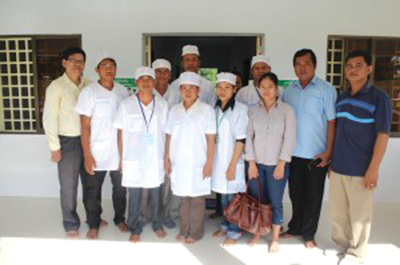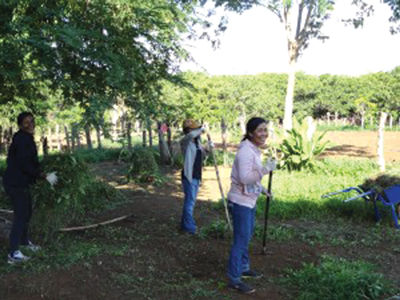
Angkor has recently helped build a health clinic.
By Joseph Kirschke, News Editor-Mining
In 2009, Angkor Gold Corp. first arrived in Cambodia with joint venture (JV) partner Liberty Mining International Pty. Ltd. of Australia not knowing entirely what to expect beneath the surface. But persistence has paid off: the Canadian junior now sits atop seven licenses strongly suggesting copper-molybdenum-porphyry mineralization and a drilling campaign pending 2015. “Geochemistry is compelling,” said CEO Mike Weeks. “There are unequivocal gold, copper and molybdenum anomalies.”
Perhaps even more compelling is what’s unfolding above ground: Angkor’s aggressive corporate social responsibility (CSR) mandate—one unlike any other in a region scarred by decades-old legacies of war, genocide and mass displacement. It’s been an uphill battle amid all the birthing pains of an emerging frontier market, but the Alberta-based miner has since booked a gold standard for sustainability in the Southeast Asian nation of 15 million.
It blooms in rainforest clearings of cassava, peppercorn, papaya and cashew patches, all testimony to a pilot program for local farmers eight hours north of here. It echoes further from the laughter of local students at a renovated school house. And it permeates villages in Ratanakiri province where newly installed wells and training to maintain them, give potable water to residents where stray animals roam freely near barefoot children alongside adults and elderly, each as frayed as the clothes on their backs.
 Staff and local employees tend to an Angkor Gold demo farm.
Staff and local employees tend to an Angkor Gold demo farm.A New, Informed Beginning
A majority of adults here bear hearts heavy with unimaginable suffering. Through the late 1970s, the Khmer Rouge inflicted one of the 20th century’s most macabre social engineering experiments on Cambodia by seeking to build an extremist agrarian utopia. Atrocities, often by teenagers, were drowned out by propaganda-blaring loudspeakers in a time of forced starvation and mass graves. More than 2 million Cambodians would perish by 1979 when Vietnamese soldiers overran Pol Pot’s regime; the rest of the world looked on passively.
Today, its people remain among Southeast Asia’s poorest. But after ASEAN and World Trade Organization (WTO) integration, Cambodia’s burgeoning economy is entering a new phase. So, too, is its modest but ambitious mining sector, where by Q2 2015, Angkor will help Mesco Gold Cambodia operate one of the country’s newest commercial projects while establishing the first mining sector royalty revenue.
Optimism resonates across the countryside. Within miles of Angkor’s licensed areas, Laos sees 30% of foreign investment in mining, while Australian juniors scour elsewhere. Cambodia’s government also greets foreign investors with open arms. And Angkor and fellow Cambodia Association for Mining and Exploration Companies (CAMEC), accordingly, are helping officials re-draft their mining code akin to a progressive Western Australian model successfully replicated in Burkina Faso in Saharan Africa.
Senior Minister Ly Thuch is effusive. “They always speak to the people and listen,” he said. “I’ve been consistently impressed; they have also met all local members of parliament and have relationships with local governments.”
It’s a small project in a small country, but Vice President for CSR Delayne Weeks sees transformational opportunity. “If we can help Cambodia make the industry attractive, it sends a message worldwide,” she said. “All stakeholders benefit—government, industry, communities and the environment.”
In this regard, Angkor engages communities through international standards of voluntary Free Prior and Informed Consent (FPIC) immediately. “All communities have to be part of the process and walk in each other’s shoes,” Weeks said. “That implies that for top government levels to engage a rural village, it has to be done outside the office, outside the boardroom, without threat or authority, so parties understand each other’s position.”
A CSR Journey
What singles Angkor out is a strictly uniform, company-wide attitude toward sustainability among all its employees; littering is all but prohibited. Indeed, noted Weeks, more than half of company shares are owned by its employees and close associates, including all management and board directors.
Historical factors have been formative, of course. Pol Pot’s fantasy of bringing Cambodia to “zero” included the wholesale elimination of its educated population. Even wearing glasses was a capital crime. Left behind were generations of families without skilled workers—one reason Angkor is especially proud of a largely local staff well-versed in both technology and the nuances of nearby communities.
Geology Project Manager Sok Vun reflected on how the company addresses often-suspicious minority indigenous groups. “Angkor is willing to provide stability,” he said. “It’s not easy (given) people’s living style and limited knowledge.”
Chief Surveyor Viseth Keo agreed. “Many indigenous people are afraid of losing their identities, their ancestor’s lands and their farms,” Keo said. But “we are building on our vision and principles in participation.”
In its mission, Angkor faces one serious difficulty, however—unique in an already complex part of the world. Since the early 1980s, that is, thousands of aid workers with good intentions and untold development assistance have flooded Cambodia from around the world—much with unseemly results.
Changing Mindsets
But above all, a “welfare” mentality has been the worst prevailing damage according to many expats here—creating a culture of dependency across villages near Angkor’s project where residents of certain communities fire blank stares at outsiders, Cambodian and foreign alike.
In Banlung, Angkor addresses this head-on via an agricultural initiative wherein staff assist farmers with productivity and income while helping them feed their families. The miner has further constructed a health clinic in Talou with medicine and services for 20,000—the first-ever in the remote, hardscrabble area.
Education is prioritized as well. At a farmhouse-turned-school near the project, 20 pupils at a time learn skills at computers donated by an Angkor shareholder; English lessons take place next door. Altogether, 240 students participate each semester; basic first aid and CPR are included. Classes take place three times daily under the instruction of two company-hired teachers.
In addition, Angkor is planning to provide education programs to promote understanding of human trafficking—a serious peril where criminal gangs bolster a notorious sex industry near largely invisible borders with Laos and Vietnam. In Phum Syarung, meanwhile, sewing instructions are provided using some of the thousands of sample bags normally used for exploration.
Among many tests facing sustainability minded miners are biased journalists, social media outlets and local nonprofits seeking to spread disruptive protests and even engender government hostility.
Only one Cambodian nongovernmental organization (NGO) armed with a television crew has tried to ambush Angkor, however. They left empty-handed.
Cambodian nationals like Angkor Logistics Coordinator Samath Ma, is armed with his own motivation. “This is my country,” he said, ploughing a Land Rover up a muddy, back-breaking road near Bantenay. “I want to do everything I can to make it better.”









